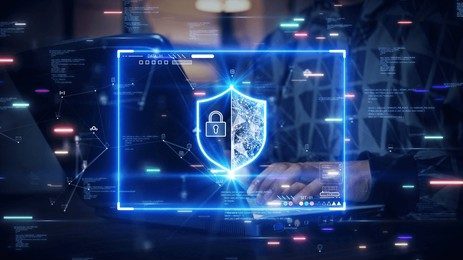
In today’s digital age, understanding the cybersecurity threat landscape is not just important—it’s imperative. The threat landscape refers to the ever-changing variety of cyber threats and vulnerabilities that could affect individuals, organisations, and governments. In Singapore, the average cost of a cybersecurity attack for organisations is approximately S$1.7 million per breach.
In a world where data crosses borders with ease, the likelihood of cyber threats has become more pronounced. Whether you’re a cybersecurity professional, a business leader, or simply an individual striving to stay informed, this article will provide key insights into the nature of the evolving cyber threat landscape.
The Current Cyber Threat Landscape
Global events and news have influenced the nature and frequency of cyber threats. Here’s what you need to know about the current state of cyber threats.
Navigating Cybersecurity in the Age of ChatGPT

OpenAI’s commitment to AI safety displayed on a mobile screen, emphasising the importance of addressing cyber security threats.
Artificial Intelligence (AI) models like ChatGPT represent an exciting yet challenging new era in cybersecurity. These advanced technologies bring many benefits, but they also pave the way for potential cyberattacks.
Malicious actors can exploit these to disrupt privacy and ethical boundaries. For instance, some users have found ways to “jailbreak” ChatGPT, overriding its ethical and privacy controls. Techniques like the ‘Do Anything Now’ (DAN) method, SWITCH method, and CHARACTER Play allow manipulation of ChatGPT to bypass its inherent safeguards, raising serious privacy and ethical issues.
One major concern is ChatGPT’s capability to generate malicious code. This lowers the barrier to engaging in cybercrime, as even those with limited technical skills can prompt ChatGPT to produce potentially harmful code.
Russian-Ukraine Conflict: A Cyber Threat Perspective
The Russian-Ukraine conflict highlights the use of cyber operations in broader military strategies, involving a range of threat actors, from state-linked groups and hacktivists to major tech companies.
Contrary to expectations of a full-scale cyberwar, Russian cyber operations have focused more on misinformation and undermining support for Kyiv, especially in the Global South, along with sporadic but less impactful cyberattacks.
The conflict has also seen the involvement of hacktivists and big tech companies reshape the cyber threat landscape. Hacktivist groups have engaged in cyber operations ranging from DDoS attacks to malware like DanaBot against Ukrainian defence ministry websites.
Big tech companies, on the other hand, have emerged as key players in providing support to the Ukrainian government and critical infrastructure sectors. Their contributions include conducting compromise assessments, providing incident response services, sharing cyber threat intelligence, and assisting in security transformation efforts.
COVID-19’s Influence on Cyber Threats
The COVID-19 pandemic has changed the cyber threat landscape, with remote work environments becoming hotbeds for cyberattacks. This change emphasises the need for enhanced cybersecurity measures and awareness, especially as we adapt to new ways of working and emerging technologies.
As many employees embraced a “work from anywhere” model, the decentralised nature of workspaces combined with new technologies has opened up additional avenues for cybercriminals. This shift has resulted in a cyberpandemic characterised by a rise in data breaches, costing organisations an average of US$4.24 million per incident.
What Is a Cyber Threat?
A cyber threat is any potential or actual malicious attack that aims to illegally access, damage, or disrupt data and digital operations. They leverage vulnerabilities in software, hardware, or human errors to achieve their goals.
Types of Cyber Threats

Transparent cybersecurity warning interface with a ‘System Hacked’ alert, illustrating the reality of cyber threats in modern computing environments.
Below are some examples of the most common types of cyber threats that individuals and organisations face today.
- Malware: This is a broad category of malicious software like viruses, worms, and trojans that pose serious threats to computer security. For example, viruses attach to clean files and spread throughout a computer system, corrupting files and impacting performance. Whereas worms replicate across networks without needing a host file, causing extensive damage.
- Ransomware Attacks: This form of malware is a prime example of digital extortion. It locks and encrypts a victim’s data, then demands a ransom for the decryption key.
- Spoofing: This involves impersonating a device, user, or network to gain unauthorised access to data. For example, in IP address spoofing, an attacker uses a trusted IP address to hijack browsers or steal data.
- Phishing Emails: Threat actors send fake messages, often in the form of emails, that look like they’re from a legitimate source. The primary goal of these threat actors is to deceive individuals into giving away sensitive information like passwords or credit card numbers.
- Business Email Compromise (BEC): In this scam, threat actors pose as company executives or vendors and trick businesses into transferring money to fraudulent accounts. BEC often targets organisations dealing with foreign suppliers or those that frequently conduct wire transfers.
- Supply Chain Attacks: Attackers infiltrate a less-secure element of the supply chain, like a third-party vendor or software provider, to gain unauthorised access to the systems and data of larger, more secure organisations.
- Distributed Denial of Service (DDoS) Attacks: These attacks disrupt normal web traffic and take targeted websites offline by overloading them with excessive internet traffic.
- Man-in-the-Middle (MitM) Attacks: A hacker secretly intercepts and alters messages between two parties who believe they are communicating directly. This can happen during any online interaction, like web browsing or emailing.
- SQL Injection: Attackers insert harmful code into a server that uses SQL, forcing it to disclose information it normally wouldn’t. This poses a threat to websites storing sensitive data, such as customer credit card details.
- Zero-Day Exploits: These attacks target unknown vulnerabilities in software, called “zero-day” because the vendor has had no time to issue a fix.
Cybersecurity Strategies To Defend Against Cyber Threats

Digital security shield encompassing a laptop as a symbol of robust cyber security measures against diverse cyber threats.
Here, we’ll explore the cybersecurity strategies that individuals and organisations can adopt to protect themselves against cyber threats.
1. Conduct Regular Security Audits and Cybersecurity Risk Assessments
Performing frequent audits and assessments of your network is crucial. It allows for the early identification and remediation of potential security gaps, preventing attackers from exploiting these weaknesses.
2. Firewalls and Antivirus Software
Firewalls act as a protective barrier between your network and the internet, filtering incoming and outgoing traffic based on established security rules. Antivirus software protects against malware by detecting and removing malicious software.
3. Use of Secure, Strong Passwords and Multi-Factor Authentication (MFA)
Strong, unique passwords combined with MFA add layers of security. MFA requires users to provide two or more verification factors to gain access to a resource.
4. Strengthening Cybersecurity Through Employee Training
Regular training for employees that focuses on identifying phishing schemes, practising effective password management, and adhering to safe internet practices can greatly reduce the risk of a breach. Such programmes empower them with the knowledge and skills to become the first line of defence against cyber threats.
5. Data Encryption
Encrypting sensitive data is a key defence against unauthorised access, safeguarding data confidentiality whether it’s stored or transmitted. This is important for protecting personal information, financial records, and intellectual property.
Join Our Cybersecurity Awareness Course Today
Cybersecurity is an integral part of effective business risk management. In today’s digital landscape, being proactive is key. Rather than just reacting to cyber threats, organisations must anticipate and be ready for potential future risks.
Learn how to assess, manage, and mitigate cyber risks within your organisation with our Cybersecurity Awareness course. Gain a deeper understanding and discover best practices like data backup, encryption, and secure browsing. Enrol now to take a crucial step towards enhancing your organisation’s cybersecurity posture!
Frequently Asked Questions
What is considered the biggest threat in today's landscape for information security?
Social engineering is the biggest threat used by cybercriminals because it exploits human error instead of technical weaknesses.
Why is cybersecurity important in the current technological landscape?
Cybersecurity is important as it protects various kinds of data from being stolen or lost. This includes sensitive information, protected health information (PHI), personally identifiable information (PII), intellectual property, personal data, and government and business information systems.


